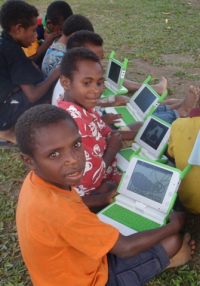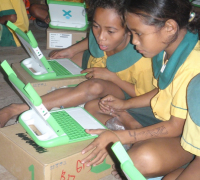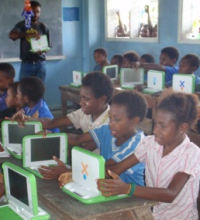As David Lemming explained to us in describing OLPC Oceania's participatory development model, the area colloquially referred to as "Oceania" is really a scattering of small countries, many with populations less than half a million, scattered across the Pacific Ocean.
They may be beautiful tropical islands, but their remote locations mean Internet costs and quality of service can be shockingly poor. Which makes the progress of OLPC Oceania all that more impressive, and I believe a model for how a one laptop per child program should be implemented in resource-poor countries.
Start Small
First, OLPC Oceania started small - just 50 XO laptops in a Solomon Islands pilot. That allowed the implementing team to take it slow, building XO cultural integration, which can be even more important that technological integration.
Even now, backed by a 5,000 XO laptop donation from OLPC itself, the program is taking measured steps to roll out programs in small doses. The team handed out 53 XO laptops in Papua New Guinea, a manageable size when:
None of the children have any experience of computers before. Of the teachers, only the Principal and one or two others are computer literate.Build Local Alliances
OLPC Oceania understood from the beginning that they needed to get buy-in from local leaders, and make technology relevant to the entire community - not just XO laptops for children.
While parents love to see kids with computers, it takes a village to make learning happen, as a practice and a priority. Just listen to how Ian Thompson describes his efforts in XO laptop distribution:
"I feel like Father Christmas! I get to give out laptops to children-who could say no to that? Not only will it help them learn, but it will also help all community members to engage with Internet technology and get connected to the global network.Build on Complimentary ActivitiesI am also excited about setting up RICS sites around the region like the one launched recently in Gaire, in Papua New Guinea."
Note that Ian has linked OLPC with both Improvement of Rural Primary Education Facilities (IRPEF) and RICS, the Rural Internet Connectivity System - 16 sites across Oceania that will provide Internet access to rural and remote Pacific communities that are currently not serviced by commercial operators. By linking XO sites to these complimentary services, all three projects are strengthened through interdependence and shared infrastructure.
Of course these efforts build on earlier activities like PFnet and DLCP which introduced information and communication technologies to remote Oceania communities and taught the project staff valuable implementation lessons.
Learn Lessons
Now guess who was the PFNet Technical Advisor and now is OLPC Oceania's Project Manager? David Lemming, who has worked in ICT for Solomon Island development since 1996.
OLPC Oceania activity reflects the collective leaning of ICT experts like David, who I see taking recommendations from his PFNet evaluation report and incorporating them into OLPC Oceania. And that may be the greatest determinant of success for OLCP Oceania - its leaders are open to learning from previous activities, and actively incorporate those lessons into the next program.
May David, Ian, and the whole OLPC Oceania team be successful yet again.
PS: Jim Gettys has a great write-up of OLPC Oceania's PNG rollout in this week's Community News.





Hello!
Did you notice the new computer desks for the XO?
They were using the box! That's a good idea!